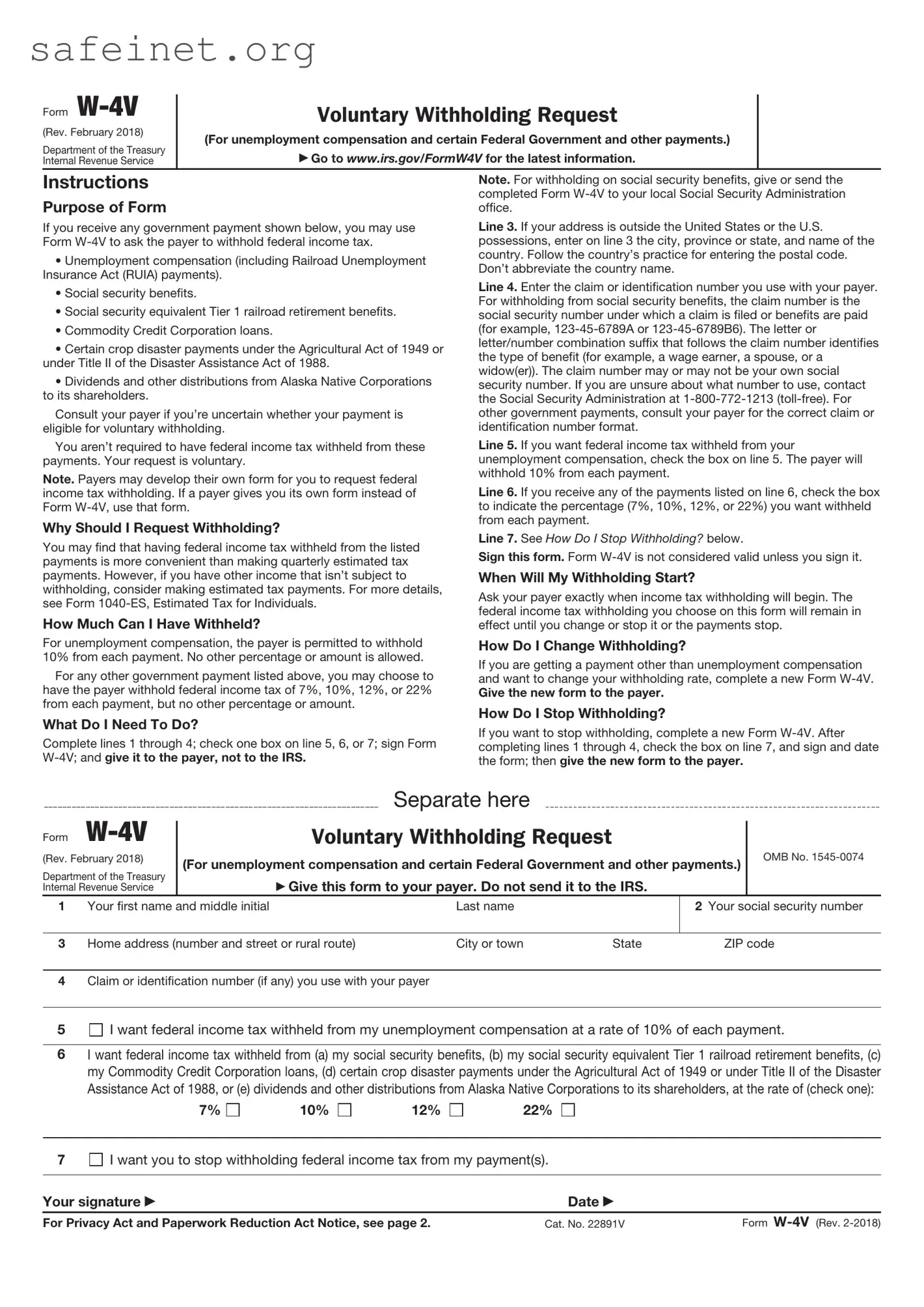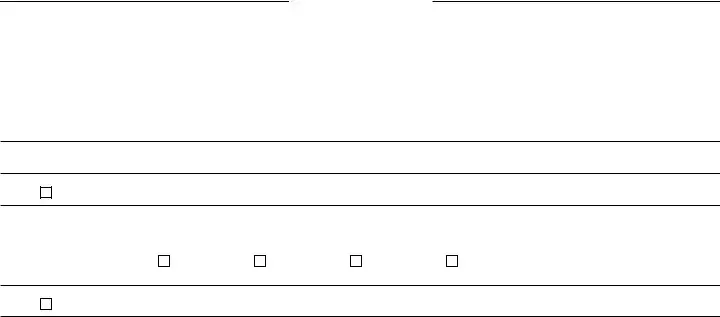|
Form |
W-4V |
|
|
Voluntary Withholding Request |
|
|
|
|
|
|
|
|
|
|
(Rev. February 2018) |
|
(For unemployment compensation and certain Federal Government and other payments.) |
|
|
Department of the Treasury |
|
|
|
|
|
Go to www.irs.gov/FormW4V for the latest information. |
|
|
|
|
Internal Revenue Service |
|
|
|
|
|
|
Instructions |
|
|
|
Note. For withholding on social security benefits, give or send the |
|
Purpose of Form |
|
|
|
completed Form W-4V to your local Social Security Administration |
|
|
|
|
office. |
|
|
|
|
|
|
If you receive any government payment shown below, you may use |
Line 3. If your address is outside the United States or the U.S. |
|
Form W-4V to ask the payer to withhold federal income tax. |
possessions, enter on line 3 the city, province or state, and name of the |
|
• Unemployment compensation (including Railroad Unemployment |
country. Follow the country’s practice for entering the postal code. |
|
Don’t abbreviate the country name. |
|
|
|
|
Insurance Act (RUIA) payments). |
|
|
|
|
|
|
Line 4. Enter the claim or identification number you use with your payer. |
|
• Social security benefits. |
|
|
|
|
|
For withholding from social security benefits, the claim number is the |
|
• Social security equivalent Tier 1 railroad retirement benefits. |
|
social security number under which a claim is filed or benefits are paid |
|
• Commodity Credit Corporation loans. |
|
(for example, 123-45-6789A or 123-45-6789B6). The letter or |
|
• Certain crop disaster payments under the Agricultural Act of 1949 or |
letter/number combination suffix that follows the claim number identifies |
|
the type of benefit (for example, a wage earner, a spouse, or a |
|
under Title II of the Disaster Assistance Act of 1988. |
|
widow(er)). The claim number may or may not be your own social |
|
• Dividends and other distributions from Alaska Native Corporations |
|
security number. If you are unsure about what number to use, contact |
|
to its shareholders. |
|
|
|
the Social Security Administration at 1-800-772-1213 (toll-free). For |
|
Consult your payer if you’re uncertain whether your payment is |
other government payments, consult your payer for the correct claim or |
|
eligible for voluntary withholding. |
|
identification number format. |
|
|
|
|
You aren’t required to have federal income tax withheld from these |
Line 5. If you want federal income tax withheld from your |
|
payments. Your request is voluntary. |
|
unemployment compensation, check the box on line 5. The payer will |
|
Note. Payers may develop their own form for you to request federal |
withhold 10% from each payment. |
|
|
|
|
Line 6. If you receive any of the payments listed on line 6, check the box |
|
income tax withholding. If a payer gives you its own form instead of |
|
Form W-4V, use that form. |
|
|
to indicate the percentage (7%, 10%, 12%, or 22%) you want withheld |
|
Why Should I Request Withholding? |
|
from each payment. |
|
|
|
|
|
|
|
Line 7. See How Do I Stop Withholding? below. |
|
|
You may find that having federal income tax withheld from the listed |
|
|
Sign this form. Form W-4V is not considered valid unless you sign it. |
|
payments is more convenient than making quarterly estimated tax |
|
|
|
|
|
|
|
|
payments. However, if you have other income that isn’t subject to |
When Will My Withholding Start? |
|
|
|
|
withholding, consider making estimated tax payments. For more details, |
Ask your payer exactly when income tax withholding will begin. The |
|
see Form 1040-ES, Estimated Tax for Individuals. |
|
federal income tax withholding you choose on this form will remain in |
|
How Much Can I Have Withheld? |
|
|
|
effect until you change or stop it or the payments stop. |
|
For unemployment compensation, the payer is permitted to withhold |
How Do I Change Withholding? |
|
|
|
|
10% from each payment. No other percentage or amount is allowed. |
If you are getting a payment other than unemployment compensation |
|
For any other government payment listed above, you may choose to |
|
and want to change your withholding rate, complete a new Form W-4V. |
|
have the payer withhold federal income tax of 7%, 10%, 12%, or 22% |
Give the new form to the payer. |
|
|
|
|
from each payment, but no other percentage or amount. |
How Do I Stop Withholding? |
|
|
|
|
What Do I Need To Do? |
|
|
|
|
|
|
|
|
If you want to stop withholding, complete a new Form W-4V. After |
|
Complete lines 1 through 4; check one box on line 5, 6, or 7; sign Form |
|
completing lines 1 through 4, check the box on line 7, and sign and date |
|
W-4V; and give it to the payer, not to the IRS. |
the form; then give the new form to the payer. |
|
|
|
|
|
|
Separate here |
|
|
|
|
|
|
Form |
W-4V |
|
|
Voluntary Withholding Request |
|
|
|
|
|
|
|
|
|
|
|
|
|
|
(Rev. February 2018) |
(For unemployment compensation and certain Federal Government and other payments.) |
|
OMB No. 1545-0074 |
|
Department of the Treasury |
|
|
|
|
|
Give this form to your payer. Do not send it to the IRS. |
|
|
|
|
Internal Revenue Service |
|
|
|
|
|
|
1 |
Your first name and middle initial |
|
Last name |
|
|
2 Your social security number |
|
|
|
|
|
|
|
|
3 |
Home address (number and street or rural route) |
City or town |
State |
ZIP code |

